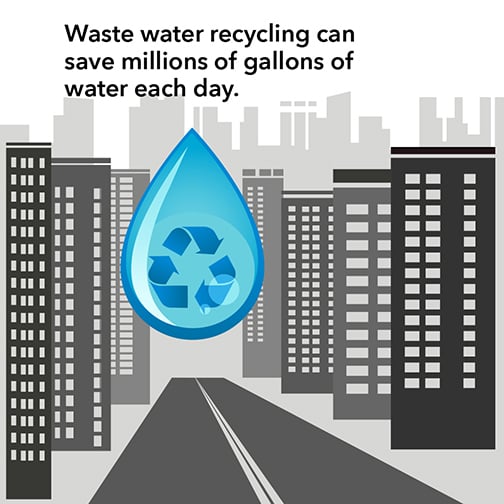 For all practical purposes, residents of the United States tend to view water as an unlimited resource. The great engineering accomplishments of Hoover Dam and Glen Canyon Dam showcased America’s ingenuity and expanding urban environments that relied upon the power and availability of water in the twentieth century.
For all practical purposes, residents of the United States tend to view water as an unlimited resource. The great engineering accomplishments of Hoover Dam and Glen Canyon Dam showcased America’s ingenuity and expanding urban environments that relied upon the power and availability of water in the twentieth century.
However, global warming and exploding population growth tell another story in our country today. Severe weather and unusual climate conditions make drought a more normal occurrence. The increased costs of water treatment and production are problems that concern everyone, not just civil engineers, real estate developers, urban planners and politicians. Because of these important factors, more people propose the reuse of waters. According to “Sustainable Water Engineering: Theory and Practice,” (2014) new and evolving technologies used to return graywater (waters treated to reliable safety standards for use in commercial building cooling towers, irrigation, or plumbing–e.g. toilet flushing— from blackwater (raw sewage) are more popular than ever before! Graywater harvesting (GwH) is also more important than ever before. Sustainable Investment Group (SIG) in Atlanta works with corporate and commercial property owners in attaining water efficiency, an integral component of LEED building certification.
Benefits of Built-In Water Recycling Systems
As sustainability and water efficiency become more important to good corporate citizens, owners of commercial properties want built-in water recycling systems. These systems clean wastewater for reuse in the building rather than release these waters into sewer systems. When the building’s system works efficiently, the building owner and the municipal sewer system and treatment facilities all benefit.
Of course, installing even small scale water reuse systems costs more—an estimated five to ten percent more—than traditional commercial plumbing and water systems. Increased demand for LEED-certified commercial buildings continues to draw greater demand for water recycling systems. LEED is the gold standard in rating green buildings’ design, operations, and construction. Since water recycling offers one of the highest numbers of points (for a single operating system within the commercial building) towards meeting required LEED standards, more commercial property owners want to explore the best ways to recycle and reuse water. According to the U.S. Green Building Council, rising annual demand for these systems continues to grow by more than ten percent.
Water Conservation
Water recycling and reuse promotes water conservation. Sydney, New South Wales’ example of One Bligh Street is a relevant example. A long drought brought developers and politicians to jointly search for water solutions. The high-rise building was fitted with a thirty-five thousand gallon a day blackwater recycle system. The system jointly recycles raw sewage from surrounding municipal sewers as well as the building’s waste water. A sophisticated modified membrane bioreactor system (MBR) delivers both first and second levels of waste water treatment. Reverse-osmosis and antimicrobial UV light is then used to sanitize the water and the effluent is drawn back to the building cooling system. The water is used for toilet flushing and for other non-potable (not drinkable) water uses.
A significant number of commercial buildings in the United States already recycle waste water. Some smaller buildings recycle mere thousands of gallons each day. However, the Johns Creek Environmental Campus (Atlanta-Fulton County waste water treatment plant) saves fifteen million gallons or more each and every day! The system makes use of active bioreactors and membranes as well as passive water filtration systems to achieve this lofty performance level.
New York Case Study
Manhattan’s Solaire condominium has been advertised as the country’s first major “green” residence. The building’s water recycle and reuse system returns twenty-five thousand gallons of greywater per day. The foundation built-in system provides six thousand gallons per day for irrigating landscape; nine thousand gallons per day for flushing toilets; and more than eleven thousand gallons per day for the building’s cooling tower. Solaire’s designers report that the waste water recycling system actually reduces potable water use by approximately fifty percent. Similarly, waste water release from the building is reduced by almost sixty percent.
Residential dwellers everywhere can make use of rain water as a simple way to reuse water for gardening or other uses. SIG offers both commercial and residential dwellers everywhere with water efficiency ideas and solutions.
Impact
According to the National Research Council (NRC), the waste water treatment and recycling efforts of commercial buildings and residences is a comparative “drop in the bucket” when compared to the amount of waste water released each day in the United States. Thirty-two billion gallons of used water flows into rivers and streams each day in our country and water treatment plants do their best to clean and return the water for reuse. NRC estimates that a significant twelve billion gallons aren’t treated and returned to the nation’s oceans and rivers.
As the population continues to increase, containing water for reuse and treatment is very important for financial and logistical reasons. Although most of today’s waste water treatment and recycling systems focus on the conversion of blackwater to graywater, some communities are thinking ahead to the inevitable future. For example, California’s drought has prompted Orange County, California to treat waste water to potable water standards. Treated water is forced into the ground in order to replenish the aquifer.
Conclusion
Waste water recycling and reuse systems are increasingly important as more cities and metropolitan communities convert to sustainable and green construction. Contact Sustainable Investment Group (SIG) to learn more about how to play your part in saving the planet today.



